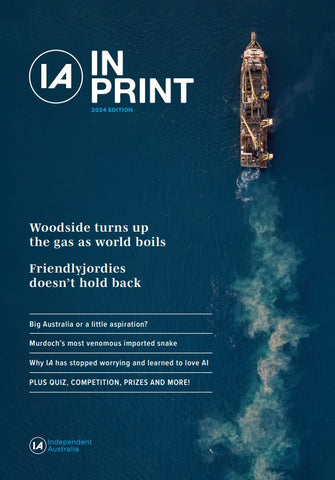As alarms are sounding about national debt, Trump deepens U.S. debt by one trillion dollars in eight weeks, as Alan Austin reports.
THE LATEST DATA from the International Monetary Fund (IMF) contains warnings for several economies whose national debt will exceed 100% of gross domestic product (GDP) next year. It offers better news for Australia, Canada, Japan and the Scandinavian countries.
The biennial IMF Fiscal Monitor, released last week, forecasts total global public debt to rise above 100% of GDP by 2029, for the first time since 1948.
The IMF is not unduly concerned about the big economies – Japan, China, France, Italy, the United Kingdom and the United States – noting they ‘typically have deep and liquid sovereign bond markets and often broad policy choices, resulting in their fiscal risk considered moderate’.
It is more anxious about lower-income countries with limited policy and funding options:
The years between the global financial crisis and the pandemic were marked by unusually easy conditions for sustaining debt. Rising debt was accompanied by falling interest rates, leading to an overall stable interest bill on budget.
But the situation is now starkly different. Interest rates have increased considerably in global markets, and their path forward is highly uncertain. Increasing debt-servicing costs are already pressuring budgets.
Australia back on track
The Albanese Government appears well-positioned to show the rest of the world how to manage awkward fiscal challenges – just as it demonstrated last week how to handle thorny negotiations over trade, tariffs and diplomatic appointments with the corrupt and impulsive Trump Administration.
The IMF report shows debt outcomes for 31 highly developed OECD members going back to 1990, with projections to 2030.
Australia ranked second or third on low debt through the Rudd/Gillard years from 2008 to 2013, only surpassed by tiny Luxembourg and Estonia. The economy then deteriorated through the Coalition period as a succession of treasurers made appallingly bad decisions in every budget they formulated.
Australia’s debt ranking tumbled from third in 2013 to 10th in 2017, then 12th in 2018 and eventually 15th in 2021. As a percentage of GDP, total debt blew out in those years from 27.5% to 57.1%. This was the worst debt expansion in the OECD.
After three Labor budgets, gross debt is now down to 51.0% of GDP, ranking 13th. (See chart below.)

The IMF shows Australia on a positive trajectory, with debt to GDP declining in each of the next five years and OECD ranking returning to the top ten by 2029.
Note on methodology
The IMF’s data includes federal, state and local government debt, which is why Australia’s 51.0% of GDP is greater than the 33.5% in last month’s Federal Budget outcomes. We will stick with IMF numbers here for comparisons with other nations, but note that this analysis underrepresents Australia’s progress.
Trump’s USA is worsening rapidly
The IMF has U.S. federal debt at 125.1% of GDP this year, with forecasts to rise above 140% by 2029 — the worst projections of all 31 nations. This appears extraordinarily pessimistic compared with elsewhere, but may in fact be optimistic.
U.S. debt has just clicked over US$38 trillion (AU$57.9) for the first time, bringing total borrowings in Trump’s second term to an eye-watering US$1.81 trillion (AU$2.74 trillion). Most of this has been added since the so-called Department of Government Efficiency ostensibly cut wasteful spending in order to reduce the deficits and the debt.
One trillion was added in just eight weeks in August and September, by far the deepest debt incurred in peacetime anywhere in the world.
Burden per taxpayer
Since Trump’s 2017 tax cuts, a total of US$17.53 trillion (AU$26.71 trillion) has been added to the federal debt unnecessarily. That’s an extra US$50,400 (AU$76,790) owed by every American man, woman, child and baby.
Interest payable this year is forecast at $1,218.5 billion (AU$1,856.52 billion). That expenditure must be met by taxpayers, or added to the burden for future taxpayers to repay, or simply continue compounding. But it must be paid.
If 163 million citizens file tax returns this year, as expected, that’s US$7,475 (AU$11,389) that taxpayers must meet, on average, just for annual interest. This will rise as long as borrowings increase.
Essential spending much lower
The astonishing thing about America’s current debt blow-out is that essential expenditure is now lower than ever.
Trump’s predecessors had to fund the Education Department, the Environmental Protection Agency, the Department of Housing and Urban Development, U.S.AID, the Agriculture Department, the Department of Energy, the Social Security Administration, the Federal Mediation and Conciliation Service, the U.S. Agency for Global Media, the Institute of Museum and Library Services and the Community Development Financial Institutions Fund.
Trump has either severely curtailed funding to these and many other departments or shut them down completely.
Where has that $1.8 trillion gone?
Now Congress refuses to monitor White House decisions, and Trump has fired the inspectors general, and the Supreme Court has given Trump monarchic powers, there are few restraints on fraud and theft.
Normally, a currency swap line of US$40 billion (AU$61 billion) for a corrupt regime in Argentina requires congressional approval, which is unlikely to be given. This is no longer the case.
Normally, a president simply helping himself to US$230 million (AU$359.56 million)from taxpayers as compensation for hurt feelings would be difficult. Now, no problem.
How many similar payments are being made in secret and how many billions are being grifted is currently unknowable. We may find out when Trump loses office. Although even that is now in doubt.
The IMF is urging the USA to reduce waste, increase tax revenue, spend more on pensions and health care, and eliminate corruption:
‘Countries with stronger governance tend to allocate more funds to areas that enhance growth. In addition, lower levels of public debt are robustly associated with growth-enhancing spending allocations.’
The Trump Administration is not listening.
Alan Austin is an Independent Australia columnist and freelance journalist. You can follow him on X/Twitter @alanaustin001.
 This work is licensed under a Creative Commons Attribution-NonCommercial-NoDerivs 3.0 Australia License
This work is licensed under a Creative Commons Attribution-NonCommercial-NoDerivs 3.0 Australia License
Support independent journalism Subscribe to IA.

Related Articles
- From the Acropolis to Mar-a-Lago: Trump and the ghost of Alcibiades
- Republican White supremacy exposed through Trump’s agenda
- God's heavy hitters smack down Trump, ‘the lying, criminal predator’
- CARTOONS: Trump's "two chances" of winning the Nobel Peace Prize
- Trump’s Gaza peace move raises questions over AUKUS priorities













